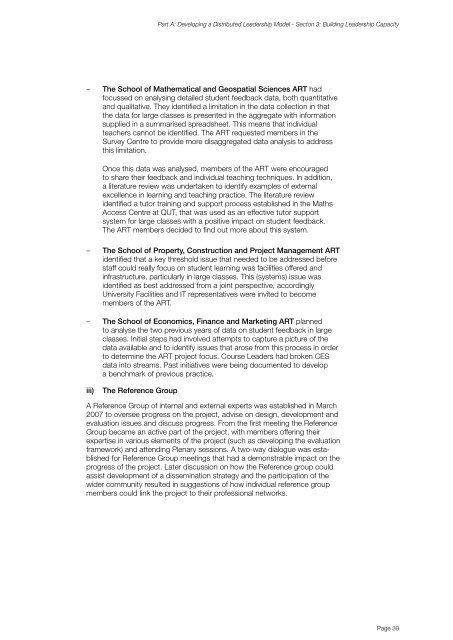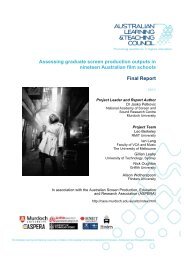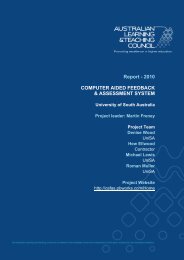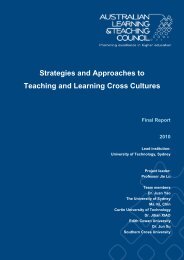student feedback and leadership - Office for Learning and Teaching
student feedback and leadership - Office for Learning and Teaching
student feedback and leadership - Office for Learning and Teaching
Create successful ePaper yourself
Turn your PDF publications into a flip-book with our unique Google optimized e-Paper software.
Part A: Developing a Distributed Leadership Model - Secton 3: Building Leadership Capacity––The School of Mathematical <strong>and</strong> Geospatial Sciences ART hadfocussed on analysing detailed <strong>student</strong> <strong>feedback</strong> data, both quantitative<strong>and</strong> qualitative. They identified a limitation in the data collection in thatthe data <strong>for</strong> large classes is presented in the aggregate with in<strong>for</strong>mationsupplied in a summarised spreadsheet. This means that individualteachers cannot be identified. The ART requested members in theSurvey Centre to provide more disaggregated data analysis to addressthis limitation.Once this data was analysed, members of the ART were encouragedto share their <strong>feedback</strong> <strong>and</strong> individual teaching techniques. In addition,a literature review was undertaken to identify examples of externalexcellence in learning <strong>and</strong> teaching practice. The literature reviewidentified a tutor training <strong>and</strong> support process established in the MathsAccess Centre at QUT, that was used as an effective tutor supportsystem <strong>for</strong> large classes with a positive impact on <strong>student</strong> <strong>feedback</strong>.The ART members decided to find out more about this system.––The School of Property, Construction <strong>and</strong> Project Management ARTidentified that a key threshold issue that needed to be addressed be<strong>for</strong>estaff could really focus on <strong>student</strong> learning was facilities offered <strong>and</strong>infrastructure, particularly in large classes. This (systems) issue wasidentified as best addressed from a joint perspective, accordinglyUniversity Facilities <strong>and</strong> IT representatives were invited to becomemembers of the ART.––The School of Economics, Finance <strong>and</strong> Marketing ART plannedto analyse the two previous years of data on <strong>student</strong> <strong>feedback</strong> in largeclasses. Initial steps had involved attempts to capture a picture of thedata available <strong>and</strong> to identify issues that arose from this process in orderto determine the ART project focus. Course Leaders had broken CESdata into streams. Past initiatives were being documented to developa benchmark of previous practice.iii)The Reference GroupA Reference Group of internal <strong>and</strong> external experts was established in March2007 to oversee progress on the project, advise on design, development <strong>and</strong>evaluation issues <strong>and</strong> discuss progress. From the first meeting the ReferenceGroup became an active part of the project, with members offering theirexpertise in various elements of the project (such as developing the evaluationframework) <strong>and</strong> attending Plenary sessions. A two-way dialogue was established<strong>for</strong> Reference Group meetings that had a demonstrable impact on theprogress of the project. Later discussion on how the Reference group couldassist development of a dissemination strategy <strong>and</strong> the participation of thewider community resulted in suggestions of how individual reference groupmembers could link the project to their professional networks.Page 39
















